Research Project: Nursing Leadership and Healthcare in LMICs
VerifiedAdded on 2023/01/05
|30
|9147
|88
Report
AI Summary
This research project, presented as an executive summary, investigates the impact of nursing leadership in Low- and Middle-Income Countries (LMICs) on healthcare outcomes. The study highlights the importance of developing leadership skills among nurses to improve healthcare system efficiency, especially given the resource constraints in these countries. The research employs a scoping review methodology, analyzing various articles and journals to identify the challenges nurses face, such as patient safety issues and financial reporting inadequacies. The study also examines the strategies adopted, including empowerment, financial improvements, and leadership competency development. The findings emphasize the crucial role of nursing leadership in motivating nurses, improving patient care, and advocating for their leadership rights, ultimately contributing to better healthcare delivery in LMICs. The report includes a table of contents, aims, objectives, background, methodology, results, and discussion, along with references to support the findings. The research highlights the need for effective nursing leadership to ensure proper care and better service for patients in these countries. The study includes findings from different articles and journals related to nursing leadership.
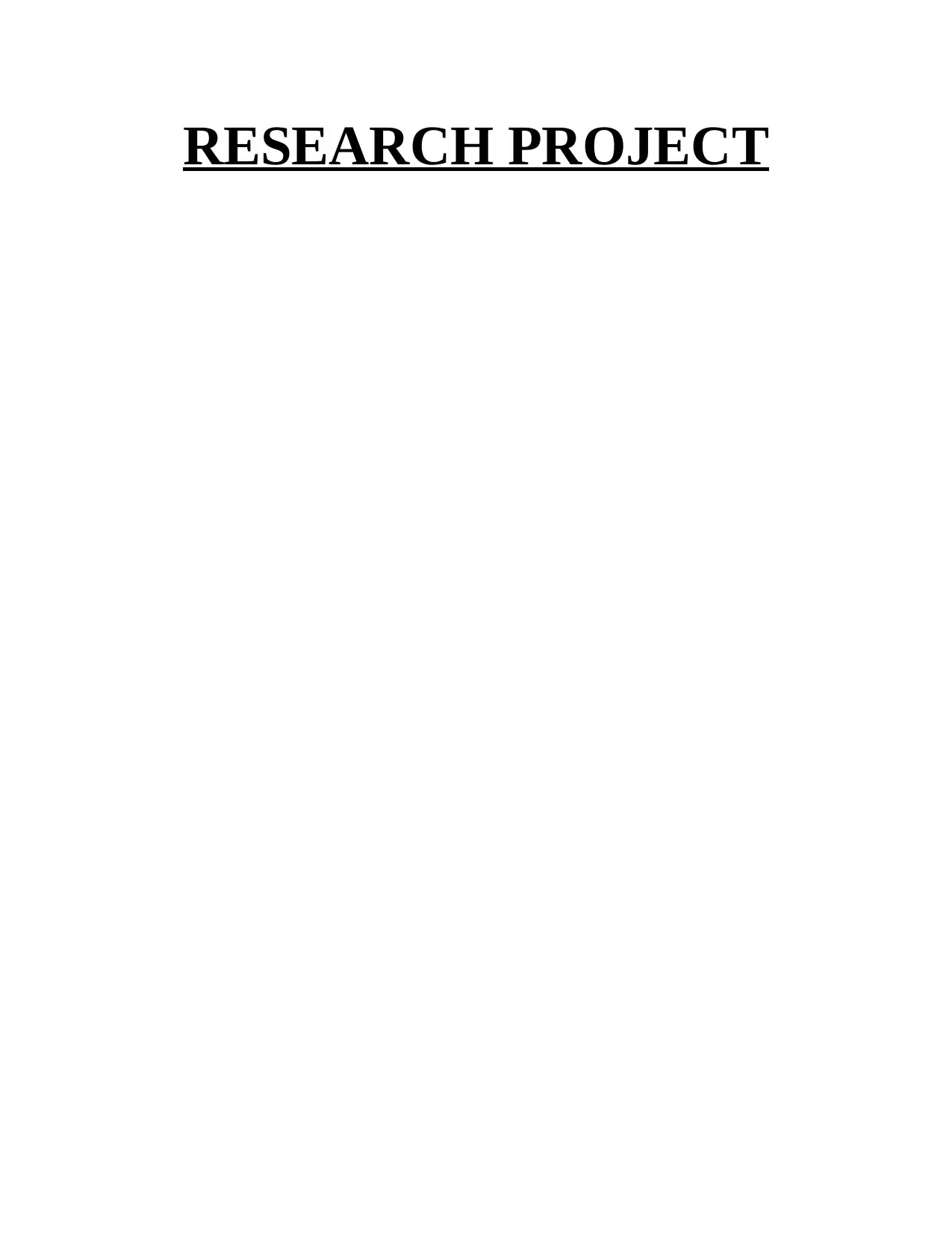
RESEARCH PROJECT
Paraphrase This Document
Need a fresh take? Get an instant paraphrase of this document with our AI Paraphraser
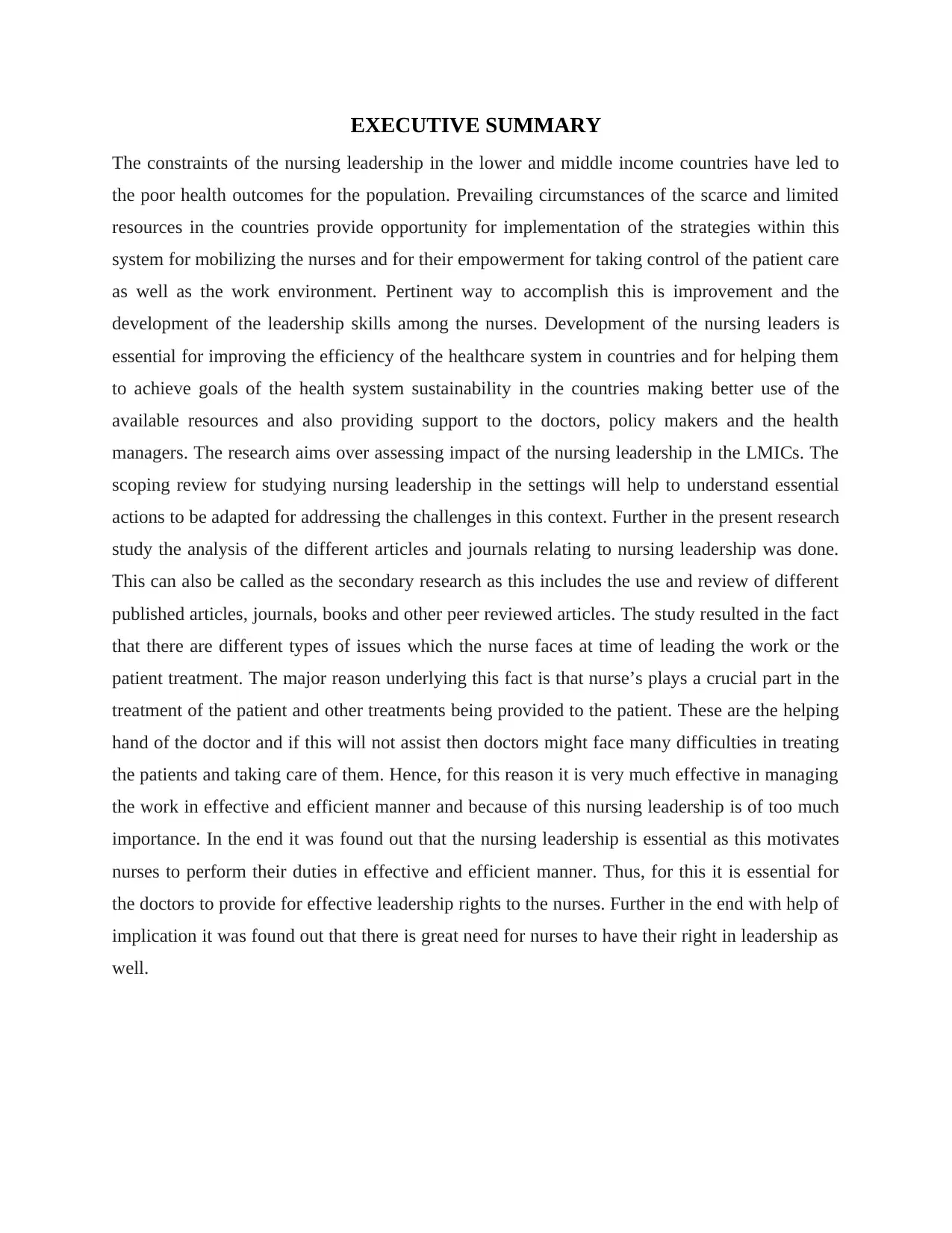
EXECUTIVE SUMMARY
The constraints of the nursing leadership in the lower and middle income countries have led to
the poor health outcomes for the population. Prevailing circumstances of the scarce and limited
resources in the countries provide opportunity for implementation of the strategies within this
system for mobilizing the nurses and for their empowerment for taking control of the patient care
as well as the work environment. Pertinent way to accomplish this is improvement and the
development of the leadership skills among the nurses. Development of the nursing leaders is
essential for improving the efficiency of the healthcare system in countries and for helping them
to achieve goals of the health system sustainability in the countries making better use of the
available resources and also providing support to the doctors, policy makers and the health
managers. The research aims over assessing impact of the nursing leadership in the LMICs. The
scoping review for studying nursing leadership in the settings will help to understand essential
actions to be adapted for addressing the challenges in this context. Further in the present research
study the analysis of the different articles and journals relating to nursing leadership was done.
This can also be called as the secondary research as this includes the use and review of different
published articles, journals, books and other peer reviewed articles. The study resulted in the fact
that there are different types of issues which the nurse faces at time of leading the work or the
patient treatment. The major reason underlying this fact is that nurse’s plays a crucial part in the
treatment of the patient and other treatments being provided to the patient. These are the helping
hand of the doctor and if this will not assist then doctors might face many difficulties in treating
the patients and taking care of them. Hence, for this reason it is very much effective in managing
the work in effective and efficient manner and because of this nursing leadership is of too much
importance. In the end it was found out that the nursing leadership is essential as this motivates
nurses to perform their duties in effective and efficient manner. Thus, for this it is essential for
the doctors to provide for effective leadership rights to the nurses. Further in the end with help of
implication it was found out that there is great need for nurses to have their right in leadership as
well.
The constraints of the nursing leadership in the lower and middle income countries have led to
the poor health outcomes for the population. Prevailing circumstances of the scarce and limited
resources in the countries provide opportunity for implementation of the strategies within this
system for mobilizing the nurses and for their empowerment for taking control of the patient care
as well as the work environment. Pertinent way to accomplish this is improvement and the
development of the leadership skills among the nurses. Development of the nursing leaders is
essential for improving the efficiency of the healthcare system in countries and for helping them
to achieve goals of the health system sustainability in the countries making better use of the
available resources and also providing support to the doctors, policy makers and the health
managers. The research aims over assessing impact of the nursing leadership in the LMICs. The
scoping review for studying nursing leadership in the settings will help to understand essential
actions to be adapted for addressing the challenges in this context. Further in the present research
study the analysis of the different articles and journals relating to nursing leadership was done.
This can also be called as the secondary research as this includes the use and review of different
published articles, journals, books and other peer reviewed articles. The study resulted in the fact
that there are different types of issues which the nurse faces at time of leading the work or the
patient treatment. The major reason underlying this fact is that nurse’s plays a crucial part in the
treatment of the patient and other treatments being provided to the patient. These are the helping
hand of the doctor and if this will not assist then doctors might face many difficulties in treating
the patients and taking care of them. Hence, for this reason it is very much effective in managing
the work in effective and efficient manner and because of this nursing leadership is of too much
importance. In the end it was found out that the nursing leadership is essential as this motivates
nurses to perform their duties in effective and efficient manner. Thus, for this it is essential for
the doctors to provide for effective leadership rights to the nurses. Further in the end with help of
implication it was found out that there is great need for nurses to have their right in leadership as
well.
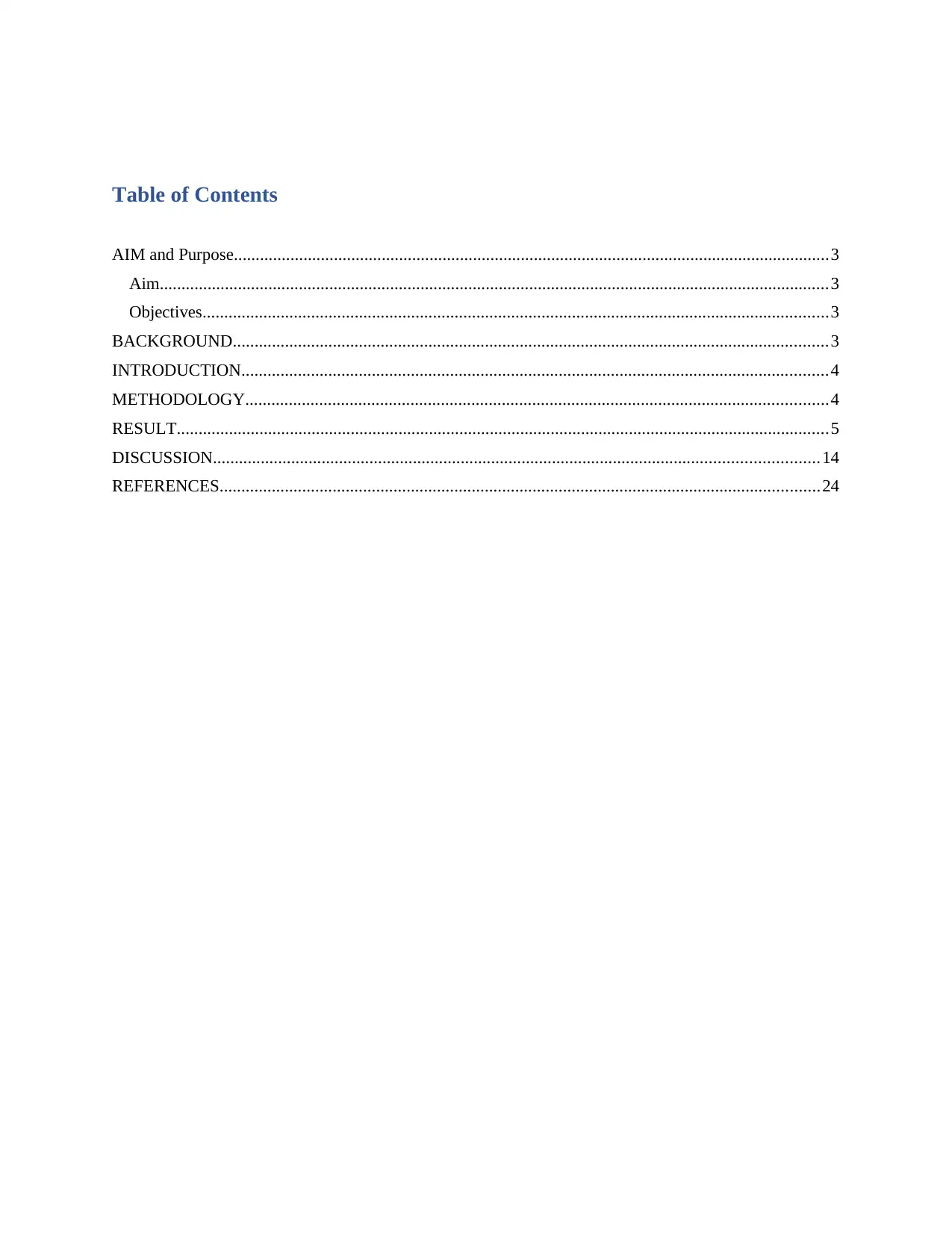
Table of Contents
AIM and Purpose.........................................................................................................................................3
Aim..........................................................................................................................................................3
Objectives................................................................................................................................................3
BACKGROUND.........................................................................................................................................3
INTRODUCTION.......................................................................................................................................4
METHODOLOGY......................................................................................................................................4
RESULT......................................................................................................................................................5
DISCUSSION...........................................................................................................................................14
REFERENCES..........................................................................................................................................24
AIM and Purpose.........................................................................................................................................3
Aim..........................................................................................................................................................3
Objectives................................................................................................................................................3
BACKGROUND.........................................................................................................................................3
INTRODUCTION.......................................................................................................................................4
METHODOLOGY......................................................................................................................................4
RESULT......................................................................................................................................................5
DISCUSSION...........................................................................................................................................14
REFERENCES..........................................................................................................................................24
⊘ This is a preview!⊘
Do you want full access?
Subscribe today to unlock all pages.

Trusted by 1+ million students worldwide
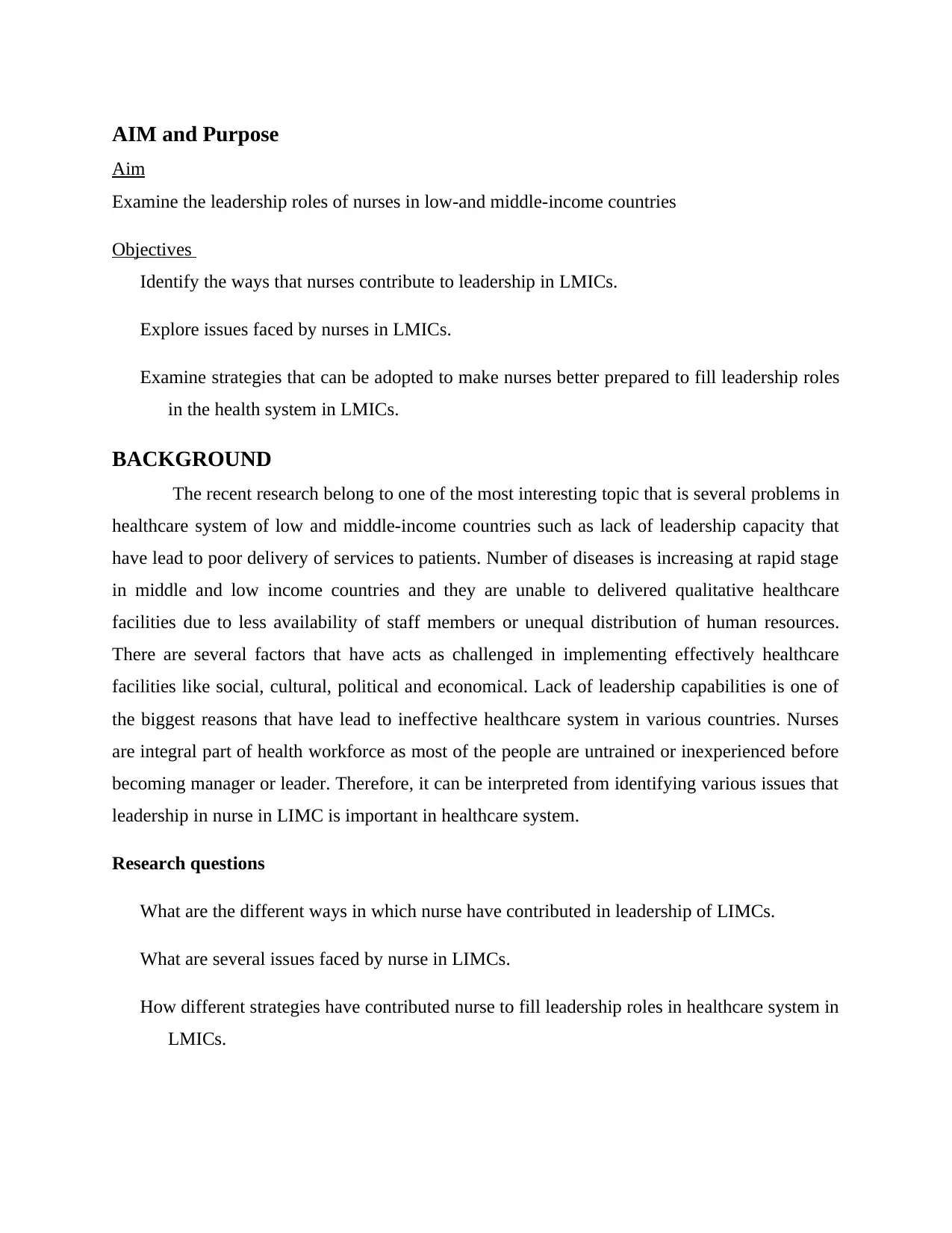
AIM and Purpose
Aim
Examine the leadership roles of nurses in low-and middle-income countries
Objectives
Identify the ways that nurses contribute to leadership in LMICs.
Explore issues faced by nurses in LMICs.
Examine strategies that can be adopted to make nurses better prepared to fill leadership roles
in the health system in LMICs.
BACKGROUND
The recent research belong to one of the most interesting topic that is several problems in
healthcare system of low and middle-income countries such as lack of leadership capacity that
have lead to poor delivery of services to patients. Number of diseases is increasing at rapid stage
in middle and low income countries and they are unable to delivered qualitative healthcare
facilities due to less availability of staff members or unequal distribution of human resources.
There are several factors that have acts as challenged in implementing effectively healthcare
facilities like social, cultural, political and economical. Lack of leadership capabilities is one of
the biggest reasons that have lead to ineffective healthcare system in various countries. Nurses
are integral part of health workforce as most of the people are untrained or inexperienced before
becoming manager or leader. Therefore, it can be interpreted from identifying various issues that
leadership in nurse in LIMC is important in healthcare system.
Research questions
What are the different ways in which nurse have contributed in leadership of LIMCs.
What are several issues faced by nurse in LIMCs.
How different strategies have contributed nurse to fill leadership roles in healthcare system in
LMICs.
Aim
Examine the leadership roles of nurses in low-and middle-income countries
Objectives
Identify the ways that nurses contribute to leadership in LMICs.
Explore issues faced by nurses in LMICs.
Examine strategies that can be adopted to make nurses better prepared to fill leadership roles
in the health system in LMICs.
BACKGROUND
The recent research belong to one of the most interesting topic that is several problems in
healthcare system of low and middle-income countries such as lack of leadership capacity that
have lead to poor delivery of services to patients. Number of diseases is increasing at rapid stage
in middle and low income countries and they are unable to delivered qualitative healthcare
facilities due to less availability of staff members or unequal distribution of human resources.
There are several factors that have acts as challenged in implementing effectively healthcare
facilities like social, cultural, political and economical. Lack of leadership capabilities is one of
the biggest reasons that have lead to ineffective healthcare system in various countries. Nurses
are integral part of health workforce as most of the people are untrained or inexperienced before
becoming manager or leader. Therefore, it can be interpreted from identifying various issues that
leadership in nurse in LIMC is important in healthcare system.
Research questions
What are the different ways in which nurse have contributed in leadership of LIMCs.
What are several issues faced by nurse in LIMCs.
How different strategies have contributed nurse to fill leadership roles in healthcare system in
LMICs.
Paraphrase This Document
Need a fresh take? Get an instant paraphrase of this document with our AI Paraphraser
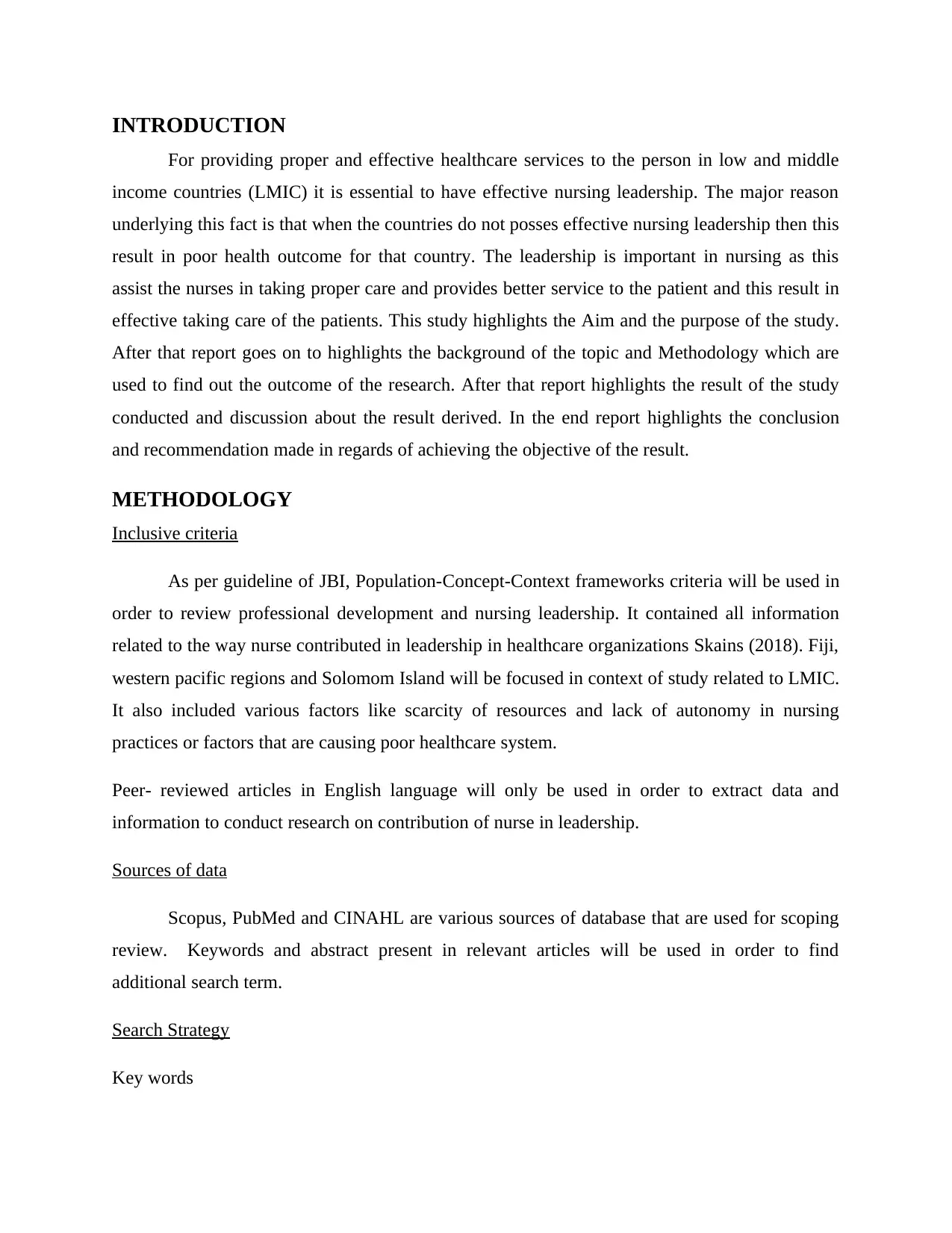
INTRODUCTION
For providing proper and effective healthcare services to the person in low and middle
income countries (LMIC) it is essential to have effective nursing leadership. The major reason
underlying this fact is that when the countries do not posses effective nursing leadership then this
result in poor health outcome for that country. The leadership is important in nursing as this
assist the nurses in taking proper care and provides better service to the patient and this result in
effective taking care of the patients. This study highlights the Aim and the purpose of the study.
After that report goes on to highlights the background of the topic and Methodology which are
used to find out the outcome of the research. After that report highlights the result of the study
conducted and discussion about the result derived. In the end report highlights the conclusion
and recommendation made in regards of achieving the objective of the result.
METHODOLOGY
Inclusive criteria
As per guideline of JBI, Population-Concept-Context frameworks criteria will be used in
order to review professional development and nursing leadership. It contained all information
related to the way nurse contributed in leadership in healthcare organizations Skains (2018). Fiji,
western pacific regions and Solomom Island will be focused in context of study related to LMIC.
It also included various factors like scarcity of resources and lack of autonomy in nursing
practices or factors that are causing poor healthcare system.
Peer- reviewed articles in English language will only be used in order to extract data and
information to conduct research on contribution of nurse in leadership.
Sources of data
Scopus, PubMed and CINAHL are various sources of database that are used for scoping
review. Keywords and abstract present in relevant articles will be used in order to find
additional search term.
Search Strategy
Key words
For providing proper and effective healthcare services to the person in low and middle
income countries (LMIC) it is essential to have effective nursing leadership. The major reason
underlying this fact is that when the countries do not posses effective nursing leadership then this
result in poor health outcome for that country. The leadership is important in nursing as this
assist the nurses in taking proper care and provides better service to the patient and this result in
effective taking care of the patients. This study highlights the Aim and the purpose of the study.
After that report goes on to highlights the background of the topic and Methodology which are
used to find out the outcome of the research. After that report highlights the result of the study
conducted and discussion about the result derived. In the end report highlights the conclusion
and recommendation made in regards of achieving the objective of the result.
METHODOLOGY
Inclusive criteria
As per guideline of JBI, Population-Concept-Context frameworks criteria will be used in
order to review professional development and nursing leadership. It contained all information
related to the way nurse contributed in leadership in healthcare organizations Skains (2018). Fiji,
western pacific regions and Solomom Island will be focused in context of study related to LMIC.
It also included various factors like scarcity of resources and lack of autonomy in nursing
practices or factors that are causing poor healthcare system.
Peer- reviewed articles in English language will only be used in order to extract data and
information to conduct research on contribution of nurse in leadership.
Sources of data
Scopus, PubMed and CINAHL are various sources of database that are used for scoping
review. Keywords and abstract present in relevant articles will be used in order to find
additional search term.
Search Strategy
Key words
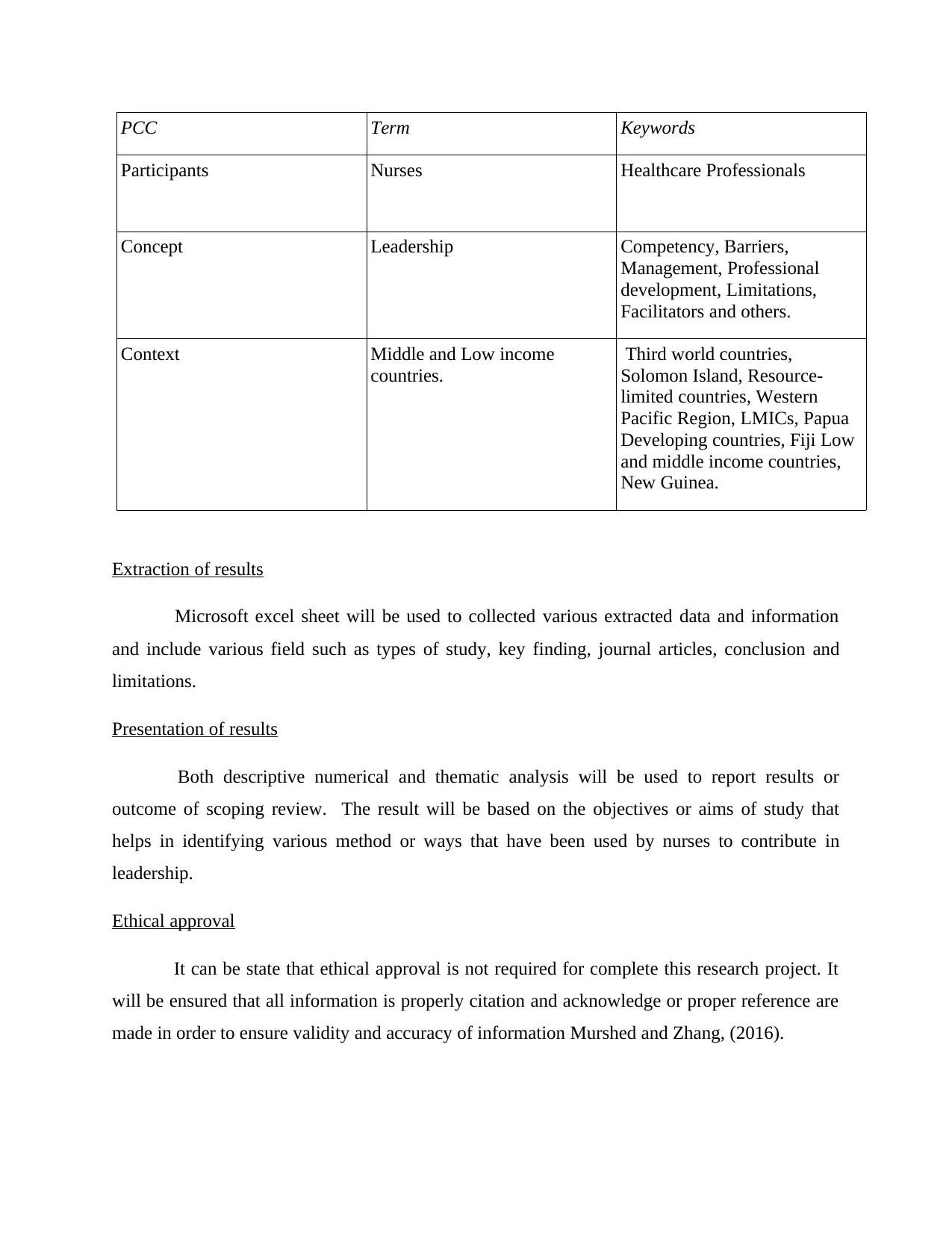
PCC Term Keywords
Participants Nurses Healthcare Professionals
Concept Leadership Competency, Barriers,
Management, Professional
development, Limitations,
Facilitators and others.
Context Middle and Low income
countries.
Third world countries,
Solomon Island, Resource-
limited countries, Western
Pacific Region, LMICs, Papua
Developing countries, Fiji Low
and middle income countries,
New Guinea.
Extraction of results
Microsoft excel sheet will be used to collected various extracted data and information
and include various field such as types of study, key finding, journal articles, conclusion and
limitations.
Presentation of results
Both descriptive numerical and thematic analysis will be used to report results or
outcome of scoping review. The result will be based on the objectives or aims of study that
helps in identifying various method or ways that have been used by nurses to contribute in
leadership.
Ethical approval
It can be state that ethical approval is not required for complete this research project. It
will be ensured that all information is properly citation and acknowledge or proper reference are
made in order to ensure validity and accuracy of information Murshed and Zhang, (2016).
Participants Nurses Healthcare Professionals
Concept Leadership Competency, Barriers,
Management, Professional
development, Limitations,
Facilitators and others.
Context Middle and Low income
countries.
Third world countries,
Solomon Island, Resource-
limited countries, Western
Pacific Region, LMICs, Papua
Developing countries, Fiji Low
and middle income countries,
New Guinea.
Extraction of results
Microsoft excel sheet will be used to collected various extracted data and information
and include various field such as types of study, key finding, journal articles, conclusion and
limitations.
Presentation of results
Both descriptive numerical and thematic analysis will be used to report results or
outcome of scoping review. The result will be based on the objectives or aims of study that
helps in identifying various method or ways that have been used by nurses to contribute in
leadership.
Ethical approval
It can be state that ethical approval is not required for complete this research project. It
will be ensured that all information is properly citation and acknowledge or proper reference are
made in order to ensure validity and accuracy of information Murshed and Zhang, (2016).
⊘ This is a preview!⊘
Do you want full access?
Subscribe today to unlock all pages.

Trusted by 1+ million students worldwide
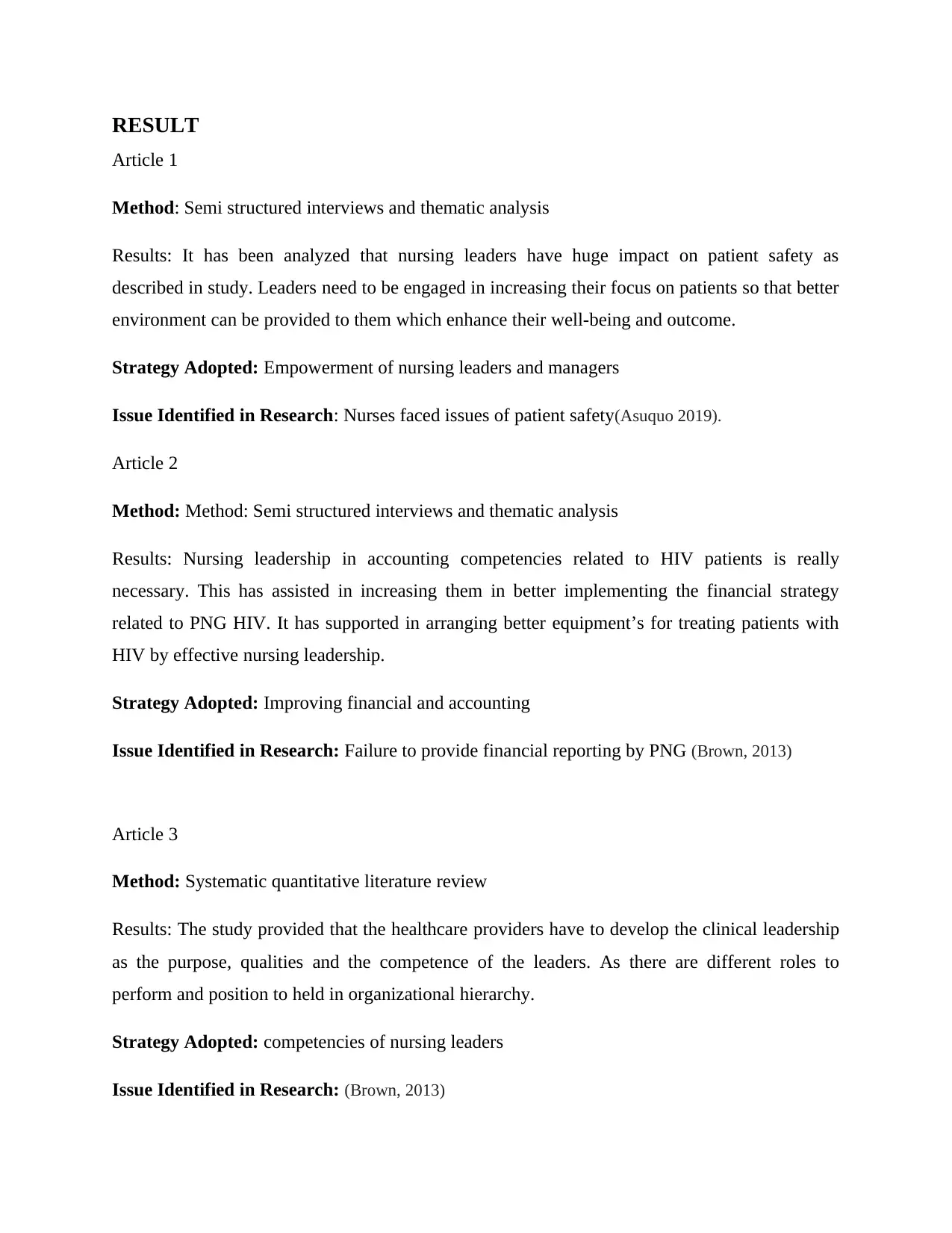
RESULT
Article 1
Method: Semi structured interviews and thematic analysis
Results: It has been analyzed that nursing leaders have huge impact on patient safety as
described in study. Leaders need to be engaged in increasing their focus on patients so that better
environment can be provided to them which enhance their well-being and outcome.
Strategy Adopted: Empowerment of nursing leaders and managers
Issue Identified in Research: Nurses faced issues of patient safety(Asuquo 2019).
Article 2
Method: Method: Semi structured interviews and thematic analysis
Results: Nursing leadership in accounting competencies related to HIV patients is really
necessary. This has assisted in increasing them in better implementing the financial strategy
related to PNG HIV. It has supported in arranging better equipment’s for treating patients with
HIV by effective nursing leadership.
Strategy Adopted: Improving financial and accounting
Issue Identified in Research: Failure to provide financial reporting by PNG (Brown, 2013)
Article 3
Method: Systematic quantitative literature review
Results: The study provided that the healthcare providers have to develop the clinical leadership
as the purpose, qualities and the competence of the leaders. As there are different roles to
perform and position to held in organizational hierarchy.
Strategy Adopted: competencies of nursing leaders
Issue Identified in Research: (Brown, 2013)
Article 1
Method: Semi structured interviews and thematic analysis
Results: It has been analyzed that nursing leaders have huge impact on patient safety as
described in study. Leaders need to be engaged in increasing their focus on patients so that better
environment can be provided to them which enhance their well-being and outcome.
Strategy Adopted: Empowerment of nursing leaders and managers
Issue Identified in Research: Nurses faced issues of patient safety(Asuquo 2019).
Article 2
Method: Method: Semi structured interviews and thematic analysis
Results: Nursing leadership in accounting competencies related to HIV patients is really
necessary. This has assisted in increasing them in better implementing the financial strategy
related to PNG HIV. It has supported in arranging better equipment’s for treating patients with
HIV by effective nursing leadership.
Strategy Adopted: Improving financial and accounting
Issue Identified in Research: Failure to provide financial reporting by PNG (Brown, 2013)
Article 3
Method: Systematic quantitative literature review
Results: The study provided that the healthcare providers have to develop the clinical leadership
as the purpose, qualities and the competence of the leaders. As there are different roles to
perform and position to held in organizational hierarchy.
Strategy Adopted: competencies of nursing leaders
Issue Identified in Research: (Brown, 2013)
Paraphrase This Document
Need a fresh take? Get an instant paraphrase of this document with our AI Paraphraser
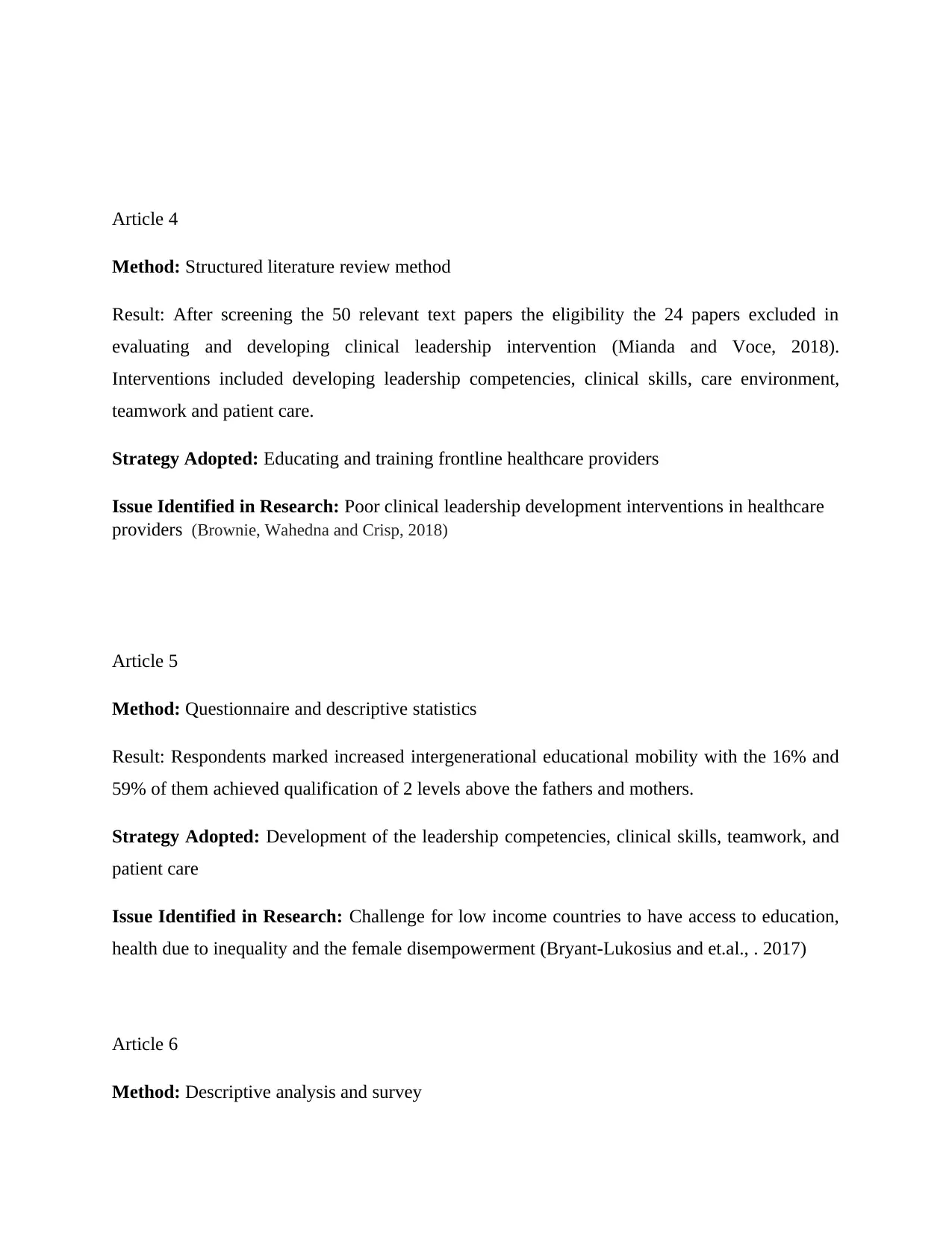
Article 4
Method: Structured literature review method
Result: After screening the 50 relevant text papers the eligibility the 24 papers excluded in
evaluating and developing clinical leadership intervention (Mianda and Voce, 2018).
Interventions included developing leadership competencies, clinical skills, care environment,
teamwork and patient care.
Strategy Adopted: Educating and training frontline healthcare providers
Issue Identified in Research: Poor clinical leadership development interventions in healthcare
providers (Brownie, Wahedna and Crisp, 2018)
Article 5
Method: Questionnaire and descriptive statistics
Result: Respondents marked increased intergenerational educational mobility with the 16% and
59% of them achieved qualification of 2 levels above the fathers and mothers.
Strategy Adopted: Development of the leadership competencies, clinical skills, teamwork, and
patient care
Issue Identified in Research: Challenge for low income countries to have access to education,
health due to inequality and the female disempowerment (Bryant-Lukosius and et.al., . 2017)
Article 6
Method: Descriptive analysis and survey
Method: Structured literature review method
Result: After screening the 50 relevant text papers the eligibility the 24 papers excluded in
evaluating and developing clinical leadership intervention (Mianda and Voce, 2018).
Interventions included developing leadership competencies, clinical skills, care environment,
teamwork and patient care.
Strategy Adopted: Educating and training frontline healthcare providers
Issue Identified in Research: Poor clinical leadership development interventions in healthcare
providers (Brownie, Wahedna and Crisp, 2018)
Article 5
Method: Questionnaire and descriptive statistics
Result: Respondents marked increased intergenerational educational mobility with the 16% and
59% of them achieved qualification of 2 levels above the fathers and mothers.
Strategy Adopted: Development of the leadership competencies, clinical skills, teamwork, and
patient care
Issue Identified in Research: Challenge for low income countries to have access to education,
health due to inequality and the female disempowerment (Bryant-Lukosius and et.al., . 2017)
Article 6
Method: Descriptive analysis and survey
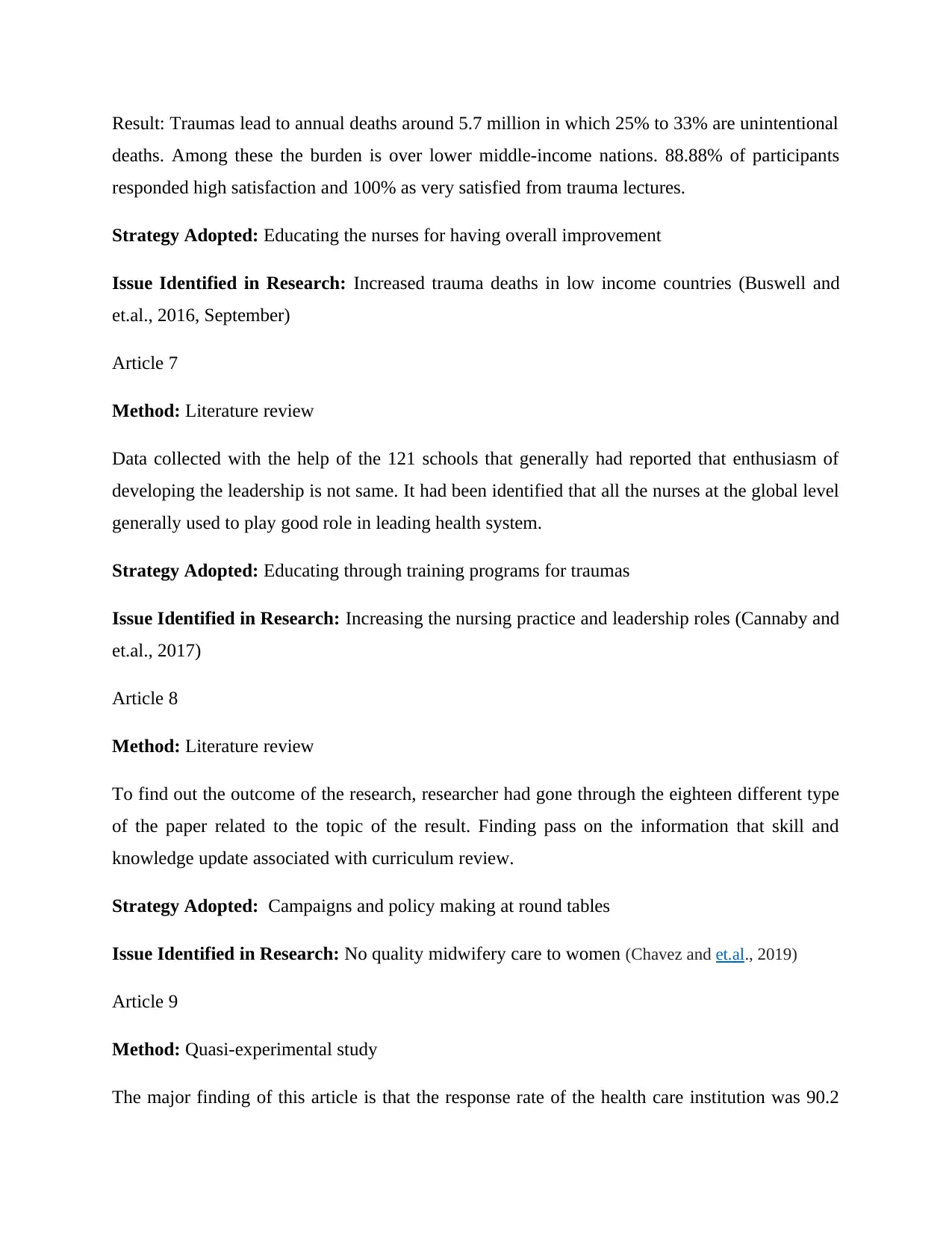
Result: Traumas lead to annual deaths around 5.7 million in which 25% to 33% are unintentional
deaths. Among these the burden is over lower middle-income nations. 88.88% of participants
responded high satisfaction and 100% as very satisfied from trauma lectures.
Strategy Adopted: Educating the nurses for having overall improvement
Issue Identified in Research: Increased trauma deaths in low income countries (Buswell and
et.al., 2016, September)
Article 7
Method: Literature review
Data collected with the help of the 121 schools that generally had reported that enthusiasm of
developing the leadership is not same. It had been identified that all the nurses at the global level
generally used to play good role in leading health system.
Strategy Adopted: Educating through training programs for traumas
Issue Identified in Research: Increasing the nursing practice and leadership roles (Cannaby and
et.al., 2017)
Article 8
Method: Literature review
To find out the outcome of the research, researcher had gone through the eighteen different type
of the paper related to the topic of the result. Finding pass on the information that skill and
knowledge update associated with curriculum review.
Strategy Adopted: Campaigns and policy making at round tables
Issue Identified in Research: No quality midwifery care to women (Chavez and et.al., 2019)
Article 9
Method: Quasi-experimental study
The major finding of this article is that the response rate of the health care institution was 90.2
deaths. Among these the burden is over lower middle-income nations. 88.88% of participants
responded high satisfaction and 100% as very satisfied from trauma lectures.
Strategy Adopted: Educating the nurses for having overall improvement
Issue Identified in Research: Increased trauma deaths in low income countries (Buswell and
et.al., 2016, September)
Article 7
Method: Literature review
Data collected with the help of the 121 schools that generally had reported that enthusiasm of
developing the leadership is not same. It had been identified that all the nurses at the global level
generally used to play good role in leading health system.
Strategy Adopted: Educating through training programs for traumas
Issue Identified in Research: Increasing the nursing practice and leadership roles (Cannaby and
et.al., 2017)
Article 8
Method: Literature review
To find out the outcome of the research, researcher had gone through the eighteen different type
of the paper related to the topic of the result. Finding pass on the information that skill and
knowledge update associated with curriculum review.
Strategy Adopted: Campaigns and policy making at round tables
Issue Identified in Research: No quality midwifery care to women (Chavez and et.al., 2019)
Article 9
Method: Quasi-experimental study
The major finding of this article is that the response rate of the health care institution was 90.2
⊘ This is a preview!⊘
Do you want full access?
Subscribe today to unlock all pages.

Trusted by 1+ million students worldwide
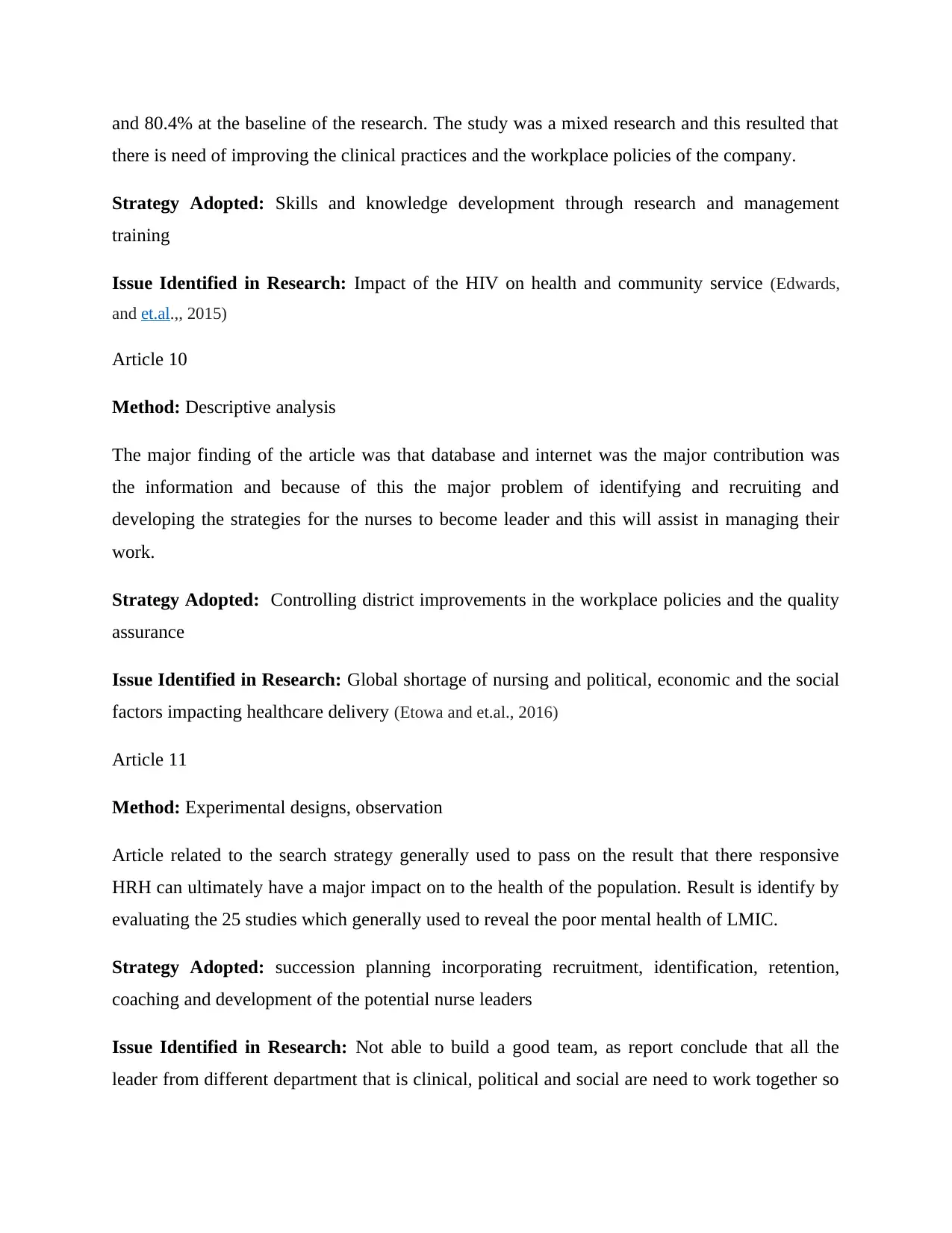
and 80.4% at the baseline of the research. The study was a mixed research and this resulted that
there is need of improving the clinical practices and the workplace policies of the company.
Strategy Adopted: Skills and knowledge development through research and management
training
Issue Identified in Research: Impact of the HIV on health and community service (Edwards,
and et.al.,, 2015)
Article 10
Method: Descriptive analysis
The major finding of the article was that database and internet was the major contribution was
the information and because of this the major problem of identifying and recruiting and
developing the strategies for the nurses to become leader and this will assist in managing their
work.
Strategy Adopted: Controlling district improvements in the workplace policies and the quality
assurance
Issue Identified in Research: Global shortage of nursing and political, economic and the social
factors impacting healthcare delivery (Etowa and et.al., 2016)
Article 11
Method: Experimental designs, observation
Article related to the search strategy generally used to pass on the result that there responsive
HRH can ultimately have a major impact on to the health of the population. Result is identify by
evaluating the 25 studies which generally used to reveal the poor mental health of LMIC.
Strategy Adopted: succession planning incorporating recruitment, identification, retention,
coaching and development of the potential nurse leaders
Issue Identified in Research: Not able to build a good team, as report conclude that all the
leader from different department that is clinical, political and social are need to work together so
there is need of improving the clinical practices and the workplace policies of the company.
Strategy Adopted: Skills and knowledge development through research and management
training
Issue Identified in Research: Impact of the HIV on health and community service (Edwards,
and et.al.,, 2015)
Article 10
Method: Descriptive analysis
The major finding of the article was that database and internet was the major contribution was
the information and because of this the major problem of identifying and recruiting and
developing the strategies for the nurses to become leader and this will assist in managing their
work.
Strategy Adopted: Controlling district improvements in the workplace policies and the quality
assurance
Issue Identified in Research: Global shortage of nursing and political, economic and the social
factors impacting healthcare delivery (Etowa and et.al., 2016)
Article 11
Method: Experimental designs, observation
Article related to the search strategy generally used to pass on the result that there responsive
HRH can ultimately have a major impact on to the health of the population. Result is identify by
evaluating the 25 studies which generally used to reveal the poor mental health of LMIC.
Strategy Adopted: succession planning incorporating recruitment, identification, retention,
coaching and development of the potential nurse leaders
Issue Identified in Research: Not able to build a good team, as report conclude that all the
leader from different department that is clinical, political and social are need to work together so
Paraphrase This Document
Need a fresh take? Get an instant paraphrase of this document with our AI Paraphraser
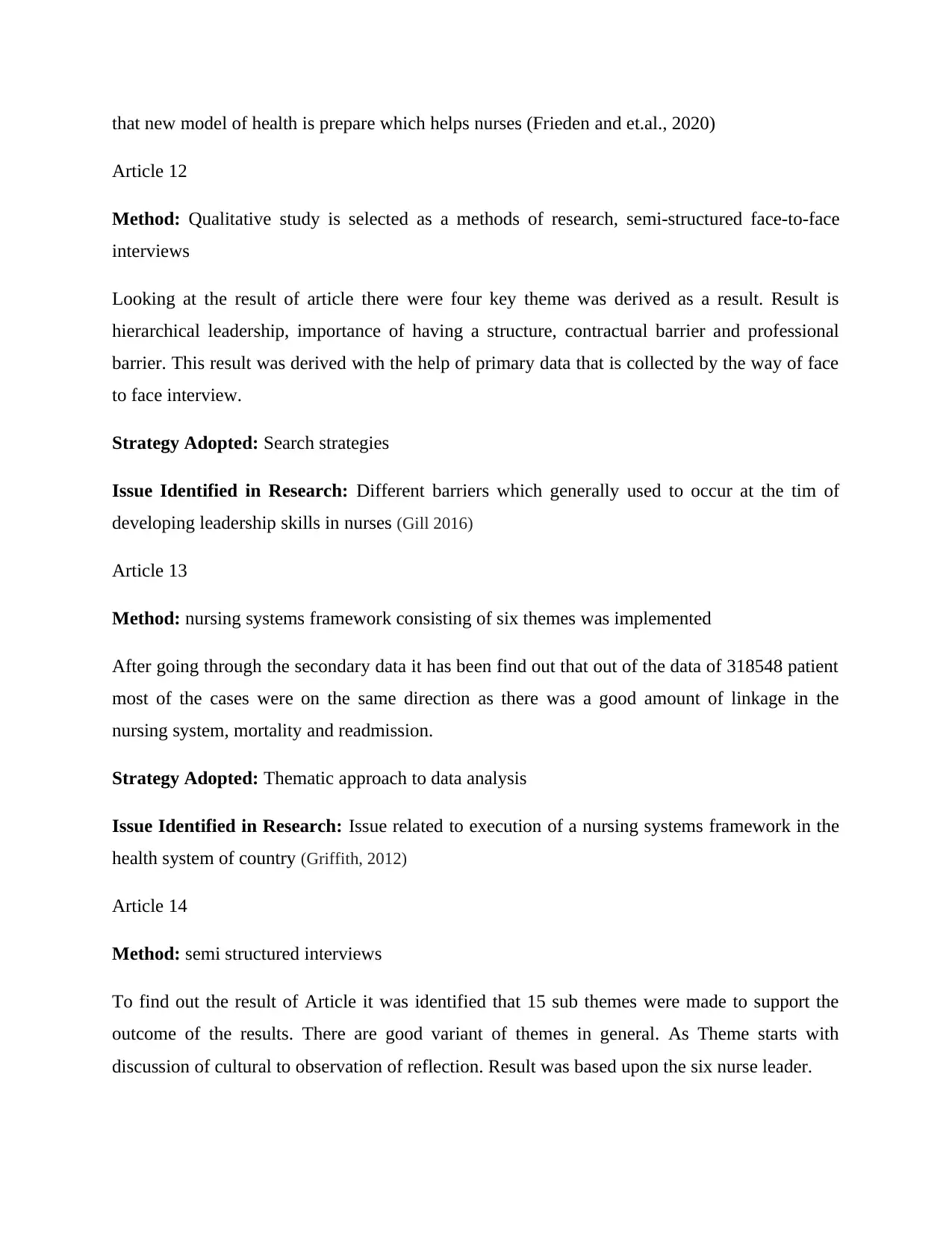
that new model of health is prepare which helps nurses (Frieden and et.al., 2020)
Article 12
Method: Qualitative study is selected as a methods of research, semi-structured face-to-face
interviews
Looking at the result of article there were four key theme was derived as a result. Result is
hierarchical leadership, importance of having a structure, contractual barrier and professional
barrier. This result was derived with the help of primary data that is collected by the way of face
to face interview.
Strategy Adopted: Search strategies
Issue Identified in Research: Different barriers which generally used to occur at the tim of
developing leadership skills in nurses (Gill 2016)
Article 13
Method: nursing systems framework consisting of six themes was implemented
After going through the secondary data it has been find out that out of the data of 318548 patient
most of the cases were on the same direction as there was a good amount of linkage in the
nursing system, mortality and readmission.
Strategy Adopted: Thematic approach to data analysis
Issue Identified in Research: Issue related to execution of a nursing systems framework in the
health system of country (Griffith, 2012)
Article 14
Method: semi structured interviews
To find out the result of Article it was identified that 15 sub themes were made to support the
outcome of the results. There are good variant of themes in general. As Theme starts with
discussion of cultural to observation of reflection. Result was based upon the six nurse leader.
Article 12
Method: Qualitative study is selected as a methods of research, semi-structured face-to-face
interviews
Looking at the result of article there were four key theme was derived as a result. Result is
hierarchical leadership, importance of having a structure, contractual barrier and professional
barrier. This result was derived with the help of primary data that is collected by the way of face
to face interview.
Strategy Adopted: Search strategies
Issue Identified in Research: Different barriers which generally used to occur at the tim of
developing leadership skills in nurses (Gill 2016)
Article 13
Method: nursing systems framework consisting of six themes was implemented
After going through the secondary data it has been find out that out of the data of 318548 patient
most of the cases were on the same direction as there was a good amount of linkage in the
nursing system, mortality and readmission.
Strategy Adopted: Thematic approach to data analysis
Issue Identified in Research: Issue related to execution of a nursing systems framework in the
health system of country (Griffith, 2012)
Article 14
Method: semi structured interviews
To find out the result of Article it was identified that 15 sub themes were made to support the
outcome of the results. There are good variant of themes in general. As Theme starts with
discussion of cultural to observation of reflection. Result was based upon the six nurse leader.
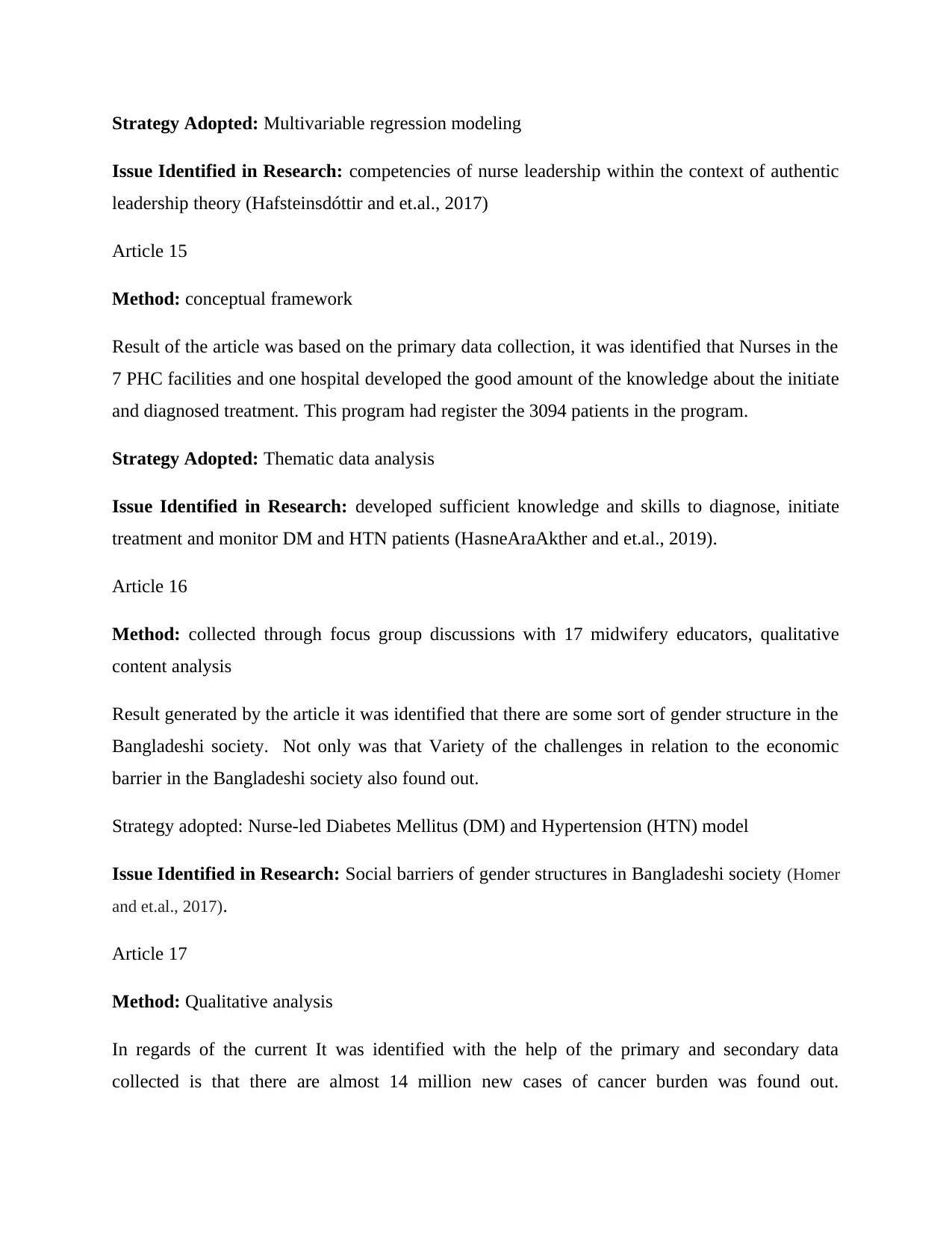
Strategy Adopted: Multivariable regression modeling
Issue Identified in Research: competencies of nurse leadership within the context of authentic
leadership theory (Hafsteinsdóttir and et.al., 2017)
Article 15
Method: conceptual framework
Result of the article was based on the primary data collection, it was identified that Nurses in the
7 PHC facilities and one hospital developed the good amount of the knowledge about the initiate
and diagnosed treatment. This program had register the 3094 patients in the program.
Strategy Adopted: Thematic data analysis
Issue Identified in Research: developed sufficient knowledge and skills to diagnose, initiate
treatment and monitor DM and HTN patients (HasneAraAkther and et.al., 2019).
Article 16
Method: collected through focus group discussions with 17 midwifery educators, qualitative
content analysis
Result generated by the article it was identified that there are some sort of gender structure in the
Bangladeshi society. Not only was that Variety of the challenges in relation to the economic
barrier in the Bangladeshi society also found out.
Strategy adopted: Nurse-led Diabetes Mellitus (DM) and Hypertension (HTN) model
Issue Identified in Research: Social barriers of gender structures in Bangladeshi society (Homer
and et.al., 2017).
Article 17
Method: Qualitative analysis
In regards of the current It was identified with the help of the primary and secondary data
collected is that there are almost 14 million new cases of cancer burden was found out.
Issue Identified in Research: competencies of nurse leadership within the context of authentic
leadership theory (Hafsteinsdóttir and et.al., 2017)
Article 15
Method: conceptual framework
Result of the article was based on the primary data collection, it was identified that Nurses in the
7 PHC facilities and one hospital developed the good amount of the knowledge about the initiate
and diagnosed treatment. This program had register the 3094 patients in the program.
Strategy Adopted: Thematic data analysis
Issue Identified in Research: developed sufficient knowledge and skills to diagnose, initiate
treatment and monitor DM and HTN patients (HasneAraAkther and et.al., 2019).
Article 16
Method: collected through focus group discussions with 17 midwifery educators, qualitative
content analysis
Result generated by the article it was identified that there are some sort of gender structure in the
Bangladeshi society. Not only was that Variety of the challenges in relation to the economic
barrier in the Bangladeshi society also found out.
Strategy adopted: Nurse-led Diabetes Mellitus (DM) and Hypertension (HTN) model
Issue Identified in Research: Social barriers of gender structures in Bangladeshi society (Homer
and et.al., 2017).
Article 17
Method: Qualitative analysis
In regards of the current It was identified with the help of the primary and secondary data
collected is that there are almost 14 million new cases of cancer burden was found out.
⊘ This is a preview!⊘
Do you want full access?
Subscribe today to unlock all pages.

Trusted by 1+ million students worldwide
1 out of 30
Related Documents
Your All-in-One AI-Powered Toolkit for Academic Success.
+13062052269
info@desklib.com
Available 24*7 on WhatsApp / Email
![[object Object]](/_next/static/media/star-bottom.7253800d.svg)
Unlock your academic potential
Copyright © 2020–2025 A2Z Services. All Rights Reserved. Developed and managed by ZUCOL.





